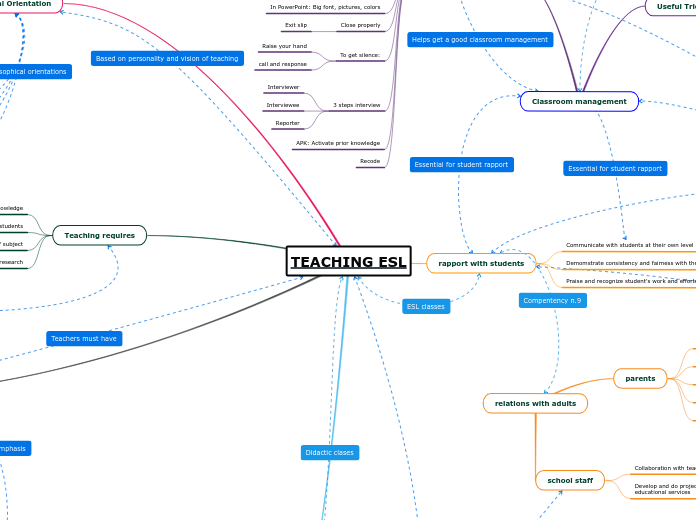Realities of teaching
3-The need for Teacher-Student Partnership
2-The Difficulty of Assessing Students’ Learning
1-Unpredictability of outcomes
6-The Uniqueness of the Teaching Experience
5-The Drama and Immediacy of Teaching
4-The Impact of Teachers’ Attitudes
Brain break
Stand up...
Do the opposite
... And say "x"
Read a text out loud
Stretch
Spell a word in the air
True or false
Go fetch someting
Glass of water
Bloom's Taxonomy
Remember
Understand
Apply
Analyze
Evaluate
Create
Multiple intelligence
Intrapersonal
Self smart
Interpersonal
People smart
Kinesthetic
Body smart
Natural
nature smart
Musical
Music smart
Spatial
Picture smart
Logical
Number smart
Linguistics
Word smart
Competencies
Competency 12
To demonstrate ethical and responsible professional behaviour
Competency 10
To cooperate and work with members of the teaching team in development and evaluation of student competencies (cycle teams)
Competency 8
Integrate ICTs in the preparation and delivery of teaching/learning activities
Competency 6
Plan, organise and supervise a class to promote learning and development (classroom management)
Competency 4
Pilot teaching/learning situations (teach!)
Competency 2
Communicate clearly in the language of instruction (both orally and in writing)
Competency 13
Integrate multi-etnicity, truly feel concerned about pedagogical actions and develop competencies about intercultural education
Competency 11
To engage in reflection to determine needs as a professional (individually and with others)
Competency 9
To cooperate with staff, parents, and other partners in education.
Competency 7
Adapt one’s teaching to the needs of students with special needs.
Competency 5
Evaluate student progress in learning
Competency 3
Develop teaching/learning situations (plan!)
Competency 1
Understand students’ and own culture. Understand and share knowledge of the subject matter according to student needs.
ICTs
Software
Zoom
Google slides
Google documents
Microsoft Excel
Power-Point
Microsoft Word
Creative apps
Flipgrid
Build Your Wild Self
Cartoonify
Mindomo
Pic Collage
Face Your Manga
Bitmoji
ComicBook
Every students are important
Students with handicap
Multi-ethnicity
Members of the teaching team
Cooperation
Developing cooperation
examples
Respect each other
identify different opinions
Build teaching competencies around students in need
Exchange ideas or tips
Agreeing and communicating in projects or tasks
Knowing when and how to form small or big groups with your colleagues
Interacting with teachers
Knowing your colleagues
Supporting each other
Internships
relations with adults
school staff
Develop and do projects in relation with school activity and educational services
Collaboration with teachers and staff
parents
Be professional with parents
Discuss about their children needs in school
Interact with parents in person or by email
Gain support from parents
Involve parents in their children education
Classroom management
Useful Tricks
Mini white boards
deck of cards (to make teams)
Popsicle sticks with students' names
Best teaching practices
Recode
APK: Activate prior knowledge
3 steps interview
Reporter
Interviewee
Interviewer
To get silence:
call and response
Raise your hand
Close properly
Exit slip
In PowerPoint: Big font, pictures, colors
Menu: What is coming up next
Name tag for students
Brain breaks
Model your explanations
Visual support
Hooks
Find the differences
Discussion
Kahoot
Quote
Video
Contest
TEACHING ESL
Humanist approach
Be aware of students' needs
Students centered class
Teacher's quality
Use appropriate language
Has creativity and initiative
cooperative attitud
Good sense of humour
Poise and confidence
Models good work habits, deportment and dress
Believes that each child can succeed
ensures lessons are relevant
Is flexible and can adapt
offers assistance outside regular class hour
Make learning an enjoyable adventure
Cares about each person in the class
Students welfare
Teaching requires
Knowledge of theory and research
How to apply it
Knowledge of subject
Knowledge of students
Self knowledge
Philosophical Orientation
Reconstructivism
Create a better civillisation
Existentialism
Focuses on the individuals
Perennialism
Prepare for life
Essentialism
Traditional learning values, hard work
Behaviorism
Consequences are important
Bad behavior
good behavior
Learning = change in behavior
Teachers
reward good behavior is best
Planning = good behavior
respond to reinforcement and group dynamics
Structured learning environment
Progressivism
Teacher
To be logical, rational decision-maker, problem solver
Active learning (Learning by doing)
Content is based on learners' interests
Learners
The whole person is considered
Interests in all forms of learning
Learners is involved in decisions making
Incorporate changes
Freedom and liberation
rapport with students
Praise and recognize student's work and efforts
Demomstrate consistency and fairness with them
Communicate with students at their own level

